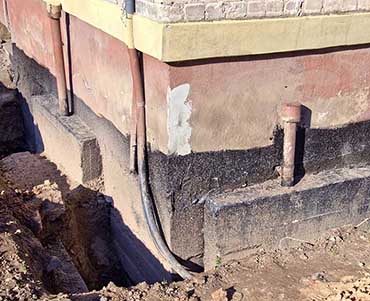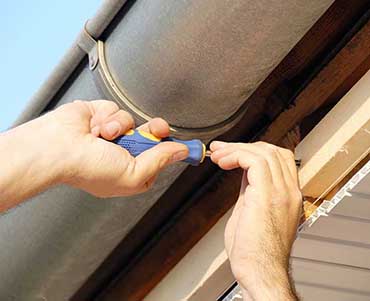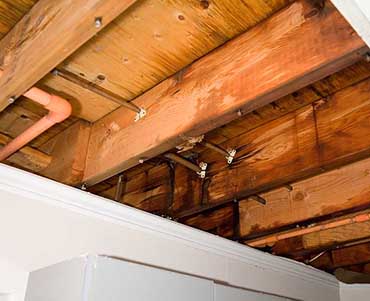
The Importance of Gutter Drain Installation
Protect Your Home from Water Damage with Professional Gutter Drain Installation Services!
Puddles can be fun for kids (and big kids) to splash in, but pooling puddles of water around your home isn’t fun. And hopefully, with each rainstorm, you aren’t watching dirt wash away from the base of your home. If the soil around your foundation is beginning to erode, or if you have puddles standing in your yard near your foundation, this is a good indicator that you have an issue that needs to be addressed.
In addition to standing water at your home, in some neighborhoods where the houses are very close together, water can collect between the houses. Bad drainage puts your home and your neighbor’s home at risk for damage to each homes’ foundations. Having effective gutters, a runoff system, and drains are important to maintain and save the foundations.
There are a few causes for rainwater that doesn’t drain properly. One can be landscaping errors. This can cause unwanted water to collect around your home. By having different elevation levels, water can be channeled away from the house. If done effectively, landscaping can be a fantastic tool in directing water toward the street curb.
Ineffective downspouts can be another issue that can cause water to stand at the base of your home. If the downspouts do not extend far enough away from the house, water won’t flow far enough away. The recommended downspout length is 6 feet. Having a downspout extension can help, but an extension won’t always solve the problem.
Signs of a Water Drainage Problem
One tell-tale sign of a drainage issue is a large puddle or many puddles in your yard. But most often, the signs are not nearly as obvious. Leaky gutters (which can go unnoticed), soggy ground, washed-away mulch, basement leaks, and cracks in the foundation are signs of an issue. Hopefully, these drainage issues will be found when they are small and easy to fix.
Cracks in the Foundation
Foundations often acquire small cracks that happen over time and those usually happen due to the house settling. This is normal and most cracks are harmless. However, bigger cracks need to be watched. Keep an eye on cracks larger than 1/8-inch wide. Measure the width and jot it down. If you notice the cracks are growing, then you have an issue with your home’s foundation.
A more obvious sign of a foundation issue is the “stair step crack”, which looks like steps going up the side of your masonry. These will widen with time and are definitely a sign that your foundation has issues that need to be addressed. The average cost of foundation repairs can run as high as $20,000. In a few cases, even more.
It seems reasonable to say that a house’s foundation is its core. A weakened or crumbling foundation can lead to uneven floors and cracked walls. Foundation issues will need to be addressed to stop these issues from worsening. Foundation problems also cause the value of your home to decrease.
Typical Gutter Configurations
Rain gutters that run along the roofline of your home are there for the purpose of catching rainwater and feeding it to ground level via the downspouts. This keeps the runoff water from seeping into the ground next to your home’s foundation. However, the gutters aren’t effectively doing their job if the downspouts aren’t taking the water away from your home. You will likely need a downspout extension to divert more water.

Splash Blocks
Splash blocks come in different materials such as concrete and plastic to. They work for small amounts of water, but aren’t able to handle a major downpour. They can prevent mud from splashing up on your house and can be decorative. However, they aren’t designed for large amounts of water, and some can be rather unattractive.
Grading
The terrain around your house should slope downward so that water is taken away from the home. Most homes are built with proper grading, but over the years, soil settles and what was once a slight slope can flatten out or even become low. One way to combat standing water is to have your yard graded for water runoff. This will work, but if you live in rather close proximity to someone, having a large grader or other machinery will be a nuisance. It may even cause damage to their yard.
French Drains
A French drain is a trench filled with gravel, containing a pipe that allows water to drain from your yard and away from your house. Depending upon the size of your drainage issue, you can possibly create the drain yourself. Don’t forget to use a catch basin along with your French drain. The big disadvantage to digging a French drain is that they can easily get a clog, backing the water up to your foundation. This is the very problem you’re trying to avoid.

The Best Gutter Drain Solution
While French drains, downspout extensions, and splash blocks all have a place and purpose, they all have disadvantages. The biggest disadvantage is that all three options allow for water to possibly end up back at the foundation of your house since none of these options are designed for large downpours of rain.
Pop-up drains are the best option if your soil isn’t draining well, your yard isn’t sloped enough to encourage runoff, or if your gutter system allows for too much water to be dumped into one area. If you’re looking for the best solution, pop up drains are definitely the best choice in a solution.
What Is a Pop-up Drain
Pop-up drain emitters are plastic cap-like structures that are attached to the end of an elbow joint, sitting just above ground level. The elbow joint is attached to a PVC pipe, which is attached directly to a downspout. The purpose of the emitter is to open with hydrostatic pressure, allowing water to flow out of the pipe and into the street or a municipal drainage pipe. It’s part of a system which will efficiently carry more water away from a home’s foundation.
A pop-up emitter is a clean-looking alternative to drain grates. If you have a drainage problem, investing in pop-up emitters is worth every dime. Having to fix foundation issues later can cost thousands of dollars. The effort and money spent now is worth not having to worry about it later.
How Pop-up Drains Work
When a rain storm hits, water flows through the gutters, down the downspout, and into a drain pipe. Pressure causes the lid to open or pop-up, and water is dispersed away from your home’s foundation. You can place the emitter at the edge of your property or you can take it all the way to the curb. Make sure wherever you place the pop-up emitter that it doesn’t affect your neighbor’s property.
Once the flow dies down, the lid shuts. This makes the emitter difficult to clog or for small animals to crawl inside. No debris can collect in the emitters when not in use. This is a great alternative to drain grates which will accumulate rocks, leaves, or debris during a heavy downpour.
Pop-Up Gutter Drain Installation
Installing pop-up drains isn’t difficult, but it does require experience and muscle. A trench will need to be dug either by hand or by renting a trench digger. First, a hole will be dug under the downspout where a catch basin will be placed. After the basin is set in the ground, the trench digging will begin.
The trench should start at the catch basin and go to a curb, creek, or another location where the runoff can drain. Fasten the flexible pipe at the bottom of the catch basin and run it along the trench. The pop-up emitter will be put at the discharge point of the pipe and positioned at ground level. Fill in the trench with dirt and fill in around the emitter. Once done, replant the old grass or lay down grass seed.
Like the gutter on your house, pop-up gutter drains need to be installed correctly so that everything works properly. The underground pipe needs to slope downward from the house to the emitter. If not, the water will not flow properly and possibly flood back into your yard. Also, the pipe must be a minimum of 6 feet away from the catch basin.
Calling in a professional installer to lay the pipe and attach the emitter is the proper way to go. Drainage specialists will know exactly what needs to be done to deal with standing water and foundation issues. Proper water management on your property is the only way to keep water from reaching your foundation and basement.
Pop-up gutter drains aren’t for every home, but for homeowners who want to make sure that runoff water is being kept away from their home, these pop-up emitters can be a very effective and tidy solution. For small amounts of water and runoff, downspout extensions, splash rocks, and French drains can help. But for larger issues and larger amounts of water, gutter drain emitters have proven to be the best solution. Call your local professional for a free estimate, and find out the right solution for you.


